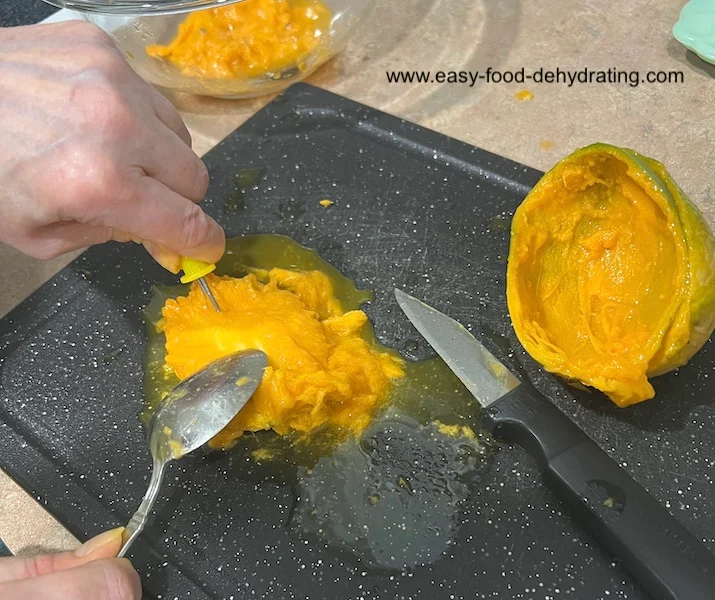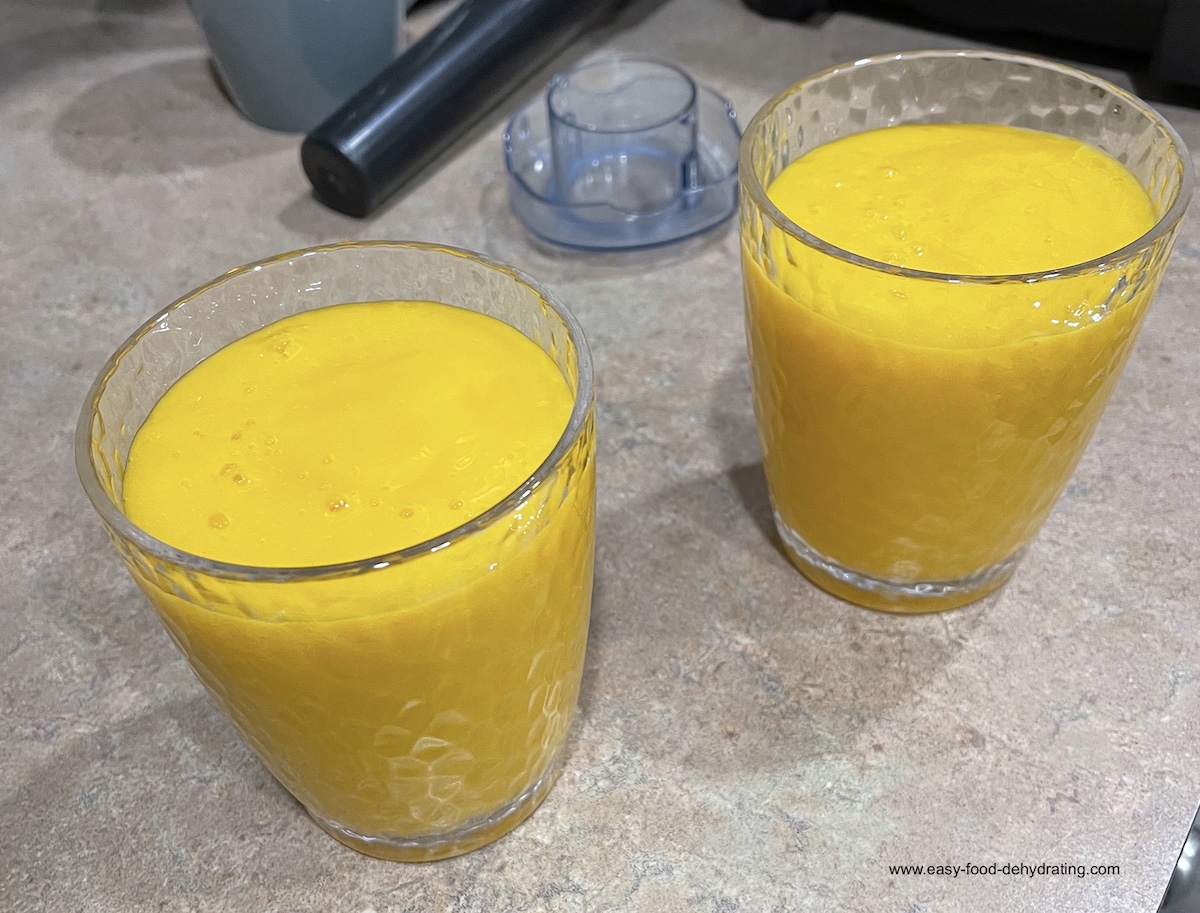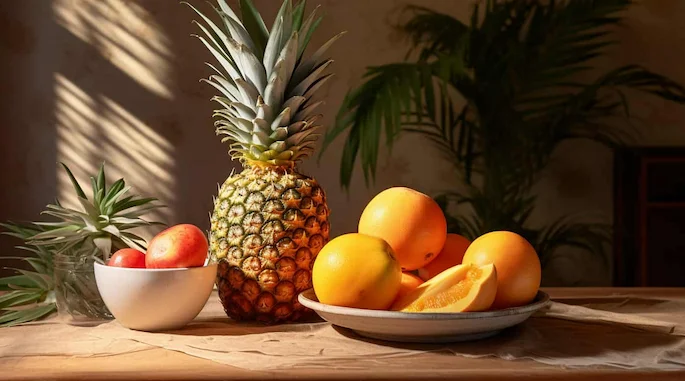What We Mean by “Dehydrate”
Here at Easy Food Dehydrating, “dehydrate” always means using an electric food dehydrator — the easy, reliable way to dry food at home.
- Home
- Dehydrating Fruits: Step-by-Step Guides by Type
- How to Dehydrate Mango: Easy Steps for Tasty Dried Fruit
How to Dehydrate Mango:
Easy Steps for Perfect Dried Fruit

Mangoes are delicious, but wow — they don’t wait around. One day they’re firm, the next they’re a stringy, slippery mess. That’s where dehydrating comes in! Drying mango slices at home not only saves them from going bad but gives you a sweet, portable snack you can stash in your pantry, hiking bag, or lunchbox.
✅ Quick Answer: How do you dehydrate mango?
Dehydrating mango is easy once you know how to handle the slippery pit and slice the fruit evenly. Use ripe—but not too soft—mangoes, cut into ¼-inch slices, and dry at 125°F–135°F for 10–12 hours. The result? Chewy, sweet snacks that store beautifully.
In this guide, I’ll walk you through how to prep, slice, dry, and store mango like a pro — with some real-life tips I’ve learned along the way.

Mango Nutrition Info.
VITAMINS: Vitamin A (beta carotene hence their orange color!), Vitamin C, Vitamin B6, Vitamin E, and Vitamin K.
MINERALS: Copper and Magnesium.
Mangoes are a good source of dietary fiber, too.
People ask me, "Is dehydrated mango good for you?" As you can see above with the number of vitamins and minerals mango contains, well yes - mango is good for you!
Begin by Using a Good Sharp Knife by Cutluxe!
Check out this great chef's knife with a full tang that means the handle and blade "are one" so they can't come apart when we're slicin' and a dicin'.
I know these Cutluxe Chef knives may be a little expensive, but they do last pretty much a lifetime when you maintain their cutting edges.
As an Amazon Associate, I earn from qualifying purchases — this does not affect the price you pay. Read full disclosure.

Don’t Let Mango Go Bad—Dehydrate It First!
For those of us who hate tossing spoiled fresh fruits or vegetables, get busy dehydrating your fresh mango before it goes off! Don't forget that dehydrated apples, bananas, and pineapples are just a few other fruits that are excellent for dehydration.
Be self-sufficient: get those fruits and veggies socked away for that rainy day - and keep your pantry full - whatever the reason or the season!
The best way to dehydrate mango is to use an electric dehydrator such as a Nesco, an Excalibur, or my new discovery: an Elite Gourmet.
🥭 Ready to turn that juicy mango into the perfect dried snack? Let’s get going...
Step-by-Step: How to Dehydrate Mango Like a Pro
Drying mangoes in a food dehydrator is easy:
- Slice off the sides of the mango into "cheeks" (see Pro Tip below)
- Scoop out the mango into 1/4" thick pieces as best you can, uniformly sized.
- Place the mango on your food dehydrator trays.
- Turn on your dehydrator and set the temperature between 125°F and 135°F (or per your food dehydrator's instructions).
Pro Tip: Tame That Slippery Pit!
Once you’ve sliced off the mango cheeks, don’t forget there’s still plenty of juicy fruit clinging to the pit. To make it easier (and way less messy), try this:
👉 Grab a 2-prong corn-on-the-cob holder and stab it right into the pit — it gives you a solid grip while you use a spoon to scrape off every last bit of mango goodness.

Your hands (and countertop) will thank you.
💡 Tip: Outside the U.S.? Most dehydrating temps here are listed in Fahrenheit - use our quick converter to see the Celsius equivalent for your machine.
- Drying time: between 10-12 hours.
- Dehydrated mango will feel flexible with no moisture.
- Remember to rotate your food dehydrator trays, for even drying.
Lay out your mango slices on the dehydrator trays in a single layer — no overlapping! Good airflow is key to even drying.
💡 If you mix big and small slices on the same tray, the smaller ones will dry out faster and could end up leathery or brittle while you're still waiting on the big ones to finish. And if you go by the small ones, the thicker pieces may stay too moist. So try to keep sizes consistent, or group similar ones together on the same tray.
Fresh, Frozen, or Canned Mango? Here’s What Works Best
If you're using canned mango, pour the opened canned contents into a sieve over your kitchen sink to let excess juicy syrup drain out. Give the pieces a quick rinse to remove any remaining sugar, and pat them dry.
When using frozen mangoes, all you have to do is let them thaw. Yes, a strainer in the kitchen sink works well. Chop up the mango in evenly-sized pieces, whether it's a fresh, canned, or frozen mango. Having the pieces the same size makes them dry at a uniform rate.
After dehydrating, allow your mango slices to cool before storing them. One step I include is called "conditioning," so please click the link to read more about that step. I do consider conditioning to be an optional step, by the way.
What we don't want to do is store 'slightly warm food' in plastic vacuum-sealer bags because you may end up with condensation inside the bags. That can cause the risk of bacterial mold growing - and that's why we add an oxygen absorber into the vacuum-sealer bag, before drawing out the air.
Preserve Your Dried Mango with 100cc Oxygen Absorbers
When storing dehydrated mango, the oxygen absorber size I use the most is a 100cc size.

When you're ready to dehydrate your batch of dried mango, open up your oxygen absorber bag and follow my trick on resealing oxygen absorber bags ASAP after opening!
Many people write in to ask if they can just use a Ziploc bag: my answer is - it depends! If you're going to be eating dried mango the day after, then sure, a Ziploc bag is fine. But if your aim is to store your dehydrated mango for long-term storage, then please use a proper vacuum-sealer bag with a 100cc oxygen absorber tucked in it (again, prior to drawing out the air with the food vacuum-sealer machine).
To be extra safe, consider adding a 5g desiccant packet along with the oxygen absorber before vacuum sealing the bag.
I use a FoodSaver brand food vacuum sealer. I've had mine for years!
A NOTE HERE about DESICCANT PACKETS
Use them in conjunction with Oxygen Absorbers.
Here's How and Why...
Too Ripe to Dry? Make a Quick Mango Smoothie Instead!

If your mango is too soft and stringy for slicing — no problem! Whip up this refreshing smoothie in seconds:
Mango Smoothie (Susan's Way):
- 2 ripe mangoes (peeled + scooped)
- 1 small bottle of apple juice (about 10–12 oz)
- ~8 ice cubes
Blend it all up until smooth. That’s it!
No added sugar needed — the mango does all the sweet talking. It’s a perfect cool-down drink for hot Florida mornings… or a sneaky way to use mangoes that got too friendly with the fruit bowl.
Spice Up Your Dried Mango: Flavor Boost Ideas
Did you know, it's quite common to add chili powder and other spices to mango? Think:
- Mango Salsa
- Mango Chutney
- Mango Lassi (flavored with chili powder, and other spices like cardamom, saffron, or cumin).
- Mangoes with Tajín (a Mexican seasoning mixture of chili peppers, lime, and salt).
How about indulging in chili mango popsicles now you know how to dehydrate mango? Simply blend the rehydrated mangoes with chili powder and lime - it makes a refreshing ice pop with a kick.
Check out this easy-release 10-Cavity Red Silicone Ice Pop mold from Amazon.com
As an Amazon Associate, I earn commission from qualifying purchases. The price you pay does not increase. Read disclosure here.
Mangoes with a sweet and sour mix are favorites in Mexico, India, and South Asian cuisines.
My mom used to love mango chutney! Check out this Indian Mango Chutney recipe. Share your dehydrated mango treats with friends and family, and make dried mango packets for your next hiking trip.

Mangoes have a flavor all their own - they're a cross between a pineapple, peach, and an apricot. Click on any of those links to see how to dehydrate those fruits specifically.
You can use fresh mango - even canned or frozen mango, too! If you opt for using fresh, make sure it's ripe. Pick one that is firm to the touch but does yield a little from the pressure of your thumb. (See more in the FAQs at the top of this post).
Where the Best Mangoes Grow (and How They Get to You)
The best areas for growing mangoes are:
- Southern Florida because the coast of Florida down to the Florida Keys enjoys a climate that's ideal for growing mangoes. Miami-Dade County is a mango-growing haven.
- Southern California because they enjoy micro-climates along the southern Cali coastline, such as San Diego County and parts of Riverside County.
- Hawaii because they too have an excellent climate for growing mangoes due to their subtropical year-round temperatures.
- Puerto Rico. This Caribbean island provides warm, humid conditions which are perfect for mango-growing.
So now you know how to dehydrate mango and where they were grown before they arrived at your grocery store or roadside stand!
Common Questions About Dehydrating Mango
(Because mangoes can be slippery little devils!)
How do you dehydrate mango in a food dehydrator?
How do you dehydrate mango in a food dehydrator?
Slice ripe mango as best you can into ¼-inch pieces, place in a single layer on dehydrator trays, and dry at 125°F–135°F for 10–12 hours. Rotate trays midway for even drying.
How do you know when a mango is ripe enough to dehydrate?
How do you know when a mango is ripe enough to dehydrate?
Look for a mango that gives slightly under thumb pressure, feels heavy for its size, and smells fruity at the stem. Too firm = underripe; too soft = better for smoothies.
What's the best way to slice a mango for dehydrating?
What's the best way to slice a mango for dehydrating?
Cut around the large pit by slicing off the “cheeks.” If firm, you can score the flesh; if soft, just scoop with a spoon. Aim for even ¼-inch slices.
How do you prevent mango from getting stringy?
How do you prevent mango from getting stringy?
Choose varieties like Tommy Atkins or Keitt mangoes, which are naturally less fibrous. Also, store ripening mangoes in the fridge to slow fiber development if you're not dehydrating them right away.
Can I dehydrate canned or frozen mango?
Can I dehydrate canned or frozen mango?
Yes! Drain canned mango, rinse off syrup, and pat dry. For frozen mango, thaw and chop into uniform pieces before drying.
How should I store dehydrated mango?
How should I store dehydrated mango?
Once cooled, store in vacuum-sealed bags with a 100cc oxygen absorber and a 5g desiccant packet for long-term shelf life. Ziploc bags work for short-term snacking.
Can I flavor mango before dehydrating?
Can I flavor mango before dehydrating?
Absolutely! Sprinkle on chili powder, Tajín, lime juice, or a pinch of salt before drying for a zesty kick.
Dehydrating mango at home is easy, affordable, and downright delicious — once you learn to wrangle that giant slippery pit and pick the right level of ripeness.
Whether you're prepping snacks for hiking trips or just hate watching fruit go bad on your counter, dried mango is a smart (and tasty!) solution. So grab your knife, fire up that dehydrator, and get slicin’. Your future snack-loving self will thank you!
Get 5 Dried Food Recipes You'll Actually Love
Here's where you can get your copy of our all new
5 Dried Food Recipes (That Actually Taste Great)
They're my all-time favorite easy dried food meals!
Get it here right now.
For Free!
Before You Go...
If you enjoyed this page, tap the ❤️ in the lower right-hand corner.
It saves this page to your Grow bookmarks so you can find it again later.
You’ll also see quick share buttons to copy the link, post to Facebook,
or save it straight to Pinterest.


















